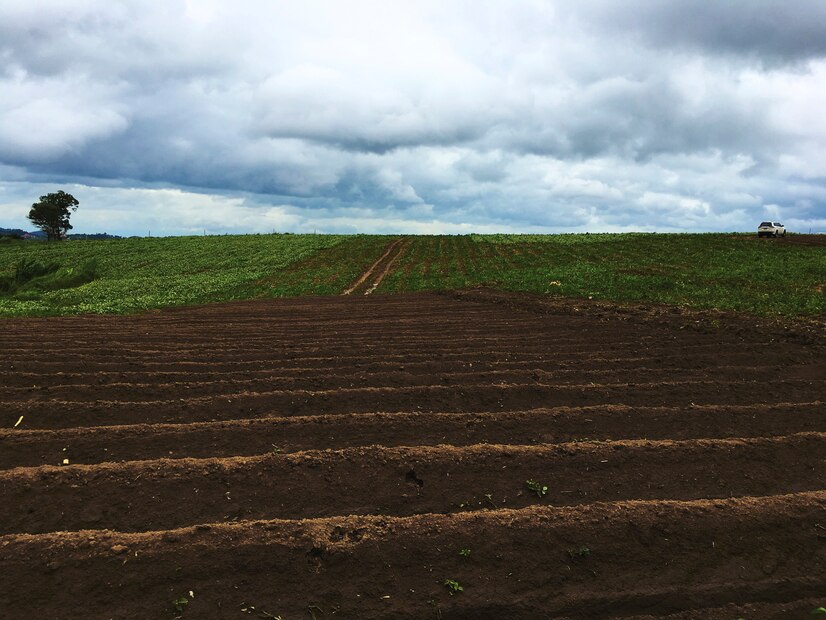Clay soil is often seen as a challenging type of soil for gardeners and farmers due to its heavy, dense texture. While clay retains moisture and nutrients well, it also tends to become compacted, poorly draining, and prone to waterlogging, which can hinder root growth and overall plant health. However, with the right strategies, clay soil can be transformed into a fertile environment that promotes healthy crop growth. Here’s how you can improve clay soil for better crop production.
1. Incorporate Organic Matter
One of the most effective ways to improve clay soil is by adding organic matter, such as compost, well-rotted manure, or leaf mold. Organic materials help break up the compacted structure of clay, improve aeration, and enhance water drainage. Over time, organic matter also helps build up beneficial microbial activity in the soil, which promotes healthy root growth.
- How to Apply: Spread a thick layer (approximately 5-10 cm) of compost or organic material over the soil surface. Use a garden fork or tiller to mix it into the soil to a depth of about 15-20 cm.
- Frequency: Add organic matter annually, especially in the first few years, until the soil begins to improve.
2. Use Cover Crops
Planting cover crops such as legumes, clover, or vetch can significantly improve clay soil structure. These crops help loosen compacted soil through their root systems, which also creates channels for air and water to penetrate more easily. Additionally, cover crops like legumes fix nitrogen in the soil, enriching it with this essential nutrient.
- How to Apply: Sow cover crops during the off-season or when the soil is not being actively cultivated. Allow the plants to grow, then cut them down and incorporate them into the soil before they go to seed.
- Recommended Crops: Legumes, clover, mustard, and oats.
3. Improve Drainage with Sand
While adding organic matter is the most effective way to improve clay soil, mixing in sand can also help improve drainage. However, it’s crucial to use coarse sand, as fine sand can exacerbate compaction. The addition of sand helps break up the sticky texture of clay, allowing excess water to drain away more easily.
- How to Apply: For every 100 square meters of clay soil, add about 100-200 kg of coarse sand. Mix the sand thoroughly into the top 15-20 cm of soil.
- Note: Be cautious with sand; excessive amounts can create a “concrete” effect when mixed with clay, so it’s best to use it in combination with organic matter.
4. Incorporate Gypsum
Gypsum (calcium sulfate) is another effective amendment for improving clay soil. It helps to flocculate (break up) clay particles, making the soil more friable and improving its structure. Unlike lime, which raises soil pH, gypsum works without affecting the soil’s acidity, making it suitable for most types of crops.
- How to Apply: Apply gypsum in the spring or fall. Use about 5-10 kg per 100 square meters of clay soil, and work it into the soil to a depth of 15 cm.
- Additional Benefits: Gypsum also helps to leach excess sodium from the soil, which can be beneficial in areas with saline conditions.
5. Practice Crop Rotation
Crop rotation involves alternating the types of crops grown in the soil each season to help maintain soil health. Growing a variety of crops in clay soil prevents nutrient depletion and reduces the risk of soil compaction. Deep-rooted plants like carrots or certain tree crops can also help loosen the soil by penetrating deeper into the clay.
- How to Apply: Rotate between crops with different root depths and nutrient needs each growing season. For example, follow legumes with leafy greens and root vegetables.
- Note: Avoid planting the same crop in the same spot year after year, as this can deplete specific soil nutrients.
6. Avoid Compaction
Clay soil is particularly prone to compaction, which can lead to poor root development, reduced water infiltration, and limited nutrient uptake. It’s essential to avoid working with wet clay soil, as this can make compaction worse. Only work the soil when it is sufficiently dry to the touch but not hard and cracked.
- How to Apply: Use garden tools designed to prevent soil compaction, such as broadforks, which help aerate the soil without causing damage. If possible, avoid walking on wet clay soil to reduce compaction caused by foot traffic.
- Tip: If you must work on wet soil, use raised garden beds or plant on mounds to minimize contact between wet soil and plant roots.
7. Use Raised Beds or Containers
For gardeners or farmers with highly compacted clay soil, using raised beds or container gardening is an excellent solution. These methods allow you to create a controlled, looser growing environment for your crops, ensuring better drainage and root growth.
- How to Apply: Build raised beds using wood, stone, or other materials. Fill them with a mixture of soil, compost, and sand or perlite to create an optimal growing medium.
- Tip: Raised beds also make it easier to manage water, nutrients, and soil temperature.
8. Regular Soil Testing
To ensure that your efforts to improve clay soil are working and to monitor soil health, it’s crucial to conduct regular soil tests. Soil tests can identify nutrient imbalances, pH levels, and other factors that influence crop growth. Based on the test results, you can adjust your soil amendments and nutrient management practices accordingly.
- How to Apply: Conduct soil tests every 1-2 years to monitor soil conditions and adjust fertilization or amendment schedules.
- Tip: Many agricultural extension services and local labs offer soil testing services at reasonable rates.
Improving clay soil for better crop growth requires patience, consistency, and the right practices. By incorporating organic matter, using cover crops, improving drainage with sand or gypsum, and taking steps to avoid compaction, you can turn even the densest, most challenging clay soil into a fertile growing medium. With these strategies, you can increase crop yields, improve soil health, and create a more sustainable agricultural system.
Join 'Farmers Mag' WhatsApp Channel
Get the latest Farming news and tips delivered straight to your WhatsApp
CLICK HERE TO JOIN






